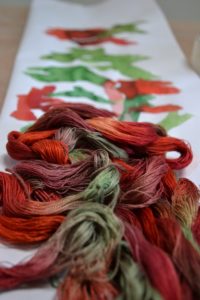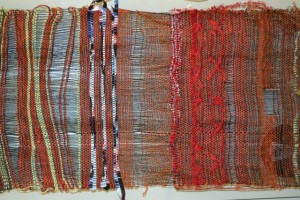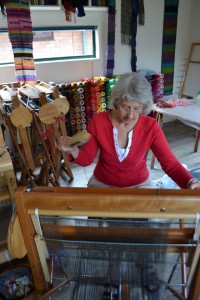 Painting a warp is much more than a mere ‘underpainting” or scaffolding for a cloth. As it becomes entwined in the weave, it forms the ground and emotion of the textile. It’s an opportunity to express a connection or meaning such as the dyes used in this image.
Painting a warp is much more than a mere ‘underpainting” or scaffolding for a cloth. As it becomes entwined in the weave, it forms the ground and emotion of the textile. It’s an opportunity to express a connection or meaning such as the dyes used in this image.
Teaching a private warp painting workshop last week allowed me to peek into and work with another artist’s ideas. Rosemary is totally inspired by aerial photo images of Lake Eyre in South Australia and it’s catching. After showing me photographic images and paintings of the area we proceeded to choose colourings for the painted warp. Although we only came up with a relatively quick summation, the rich tones of reds, oranges and greyed greens were beautiful. A grey dye mix was added to the colours to emulate the greyed soft tones of our Australian landscape.
 Although I love Australian landscape paintings, I tend to look at other sources of life for my weave designs. But this foray into our landscapes has me fired up about its possibilities. Everywhere I look at our landscape I see such secretive and immense detailed beauty. The Australian bush doesn’t yell ‘bright’ or ‘look at me’ but invites a look closer to see amazing intricacies and colours of a subdued and weathered landscape always renewing itself in some way. It seems laid back and nonchalant yet always awaiting extremes – wet/dry/fire/sun.
Although I love Australian landscape paintings, I tend to look at other sources of life for my weave designs. But this foray into our landscapes has me fired up about its possibilities. Everywhere I look at our landscape I see such secretive and immense detailed beauty. The Australian bush doesn’t yell ‘bright’ or ‘look at me’ but invites a look closer to see amazing intricacies and colours of a subdued and weathered landscape always renewing itself in some way. It seems laid back and nonchalant yet always awaiting extremes – wet/dry/fire/sun.
 Earlier in the year I was introduced to India Flint’s world and perhaps this laid the ground for my mini epithany now. With eco-dyeing you source your surroundings to create a textile that’s directly connected to where you are, where you live and where you exist. Your dyes are part of you and your experiences. I’m also enjoying seeing local weaver and textile artist , Marilyn Rutledge, building links between eco-dyeing and weave with textiles that directly reflect and contain imprints and colours of our own environment – its plants and trees and something of our community.
Earlier in the year I was introduced to India Flint’s world and perhaps this laid the ground for my mini epithany now. With eco-dyeing you source your surroundings to create a textile that’s directly connected to where you are, where you live and where you exist. Your dyes are part of you and your experiences. I’m also enjoying seeing local weaver and textile artist , Marilyn Rutledge, building links between eco-dyeing and weave with textiles that directly reflect and contain imprints and colours of our own environment – its plants and trees and something of our community.
Rosemary’s Saori workshop piece focused on the Lake Eyre colours but also the textures and forms of the ground. Coming from a tapestry weaving background you can see this approach in the work photographed above. I love it all. But if you’re reading this you know the feeling and I’m not revealing anything new.
Colour, form, texture and technique are all ways of expressing our connection and appreciation for our environment and the landscapes that surround us.

Leave a Reply